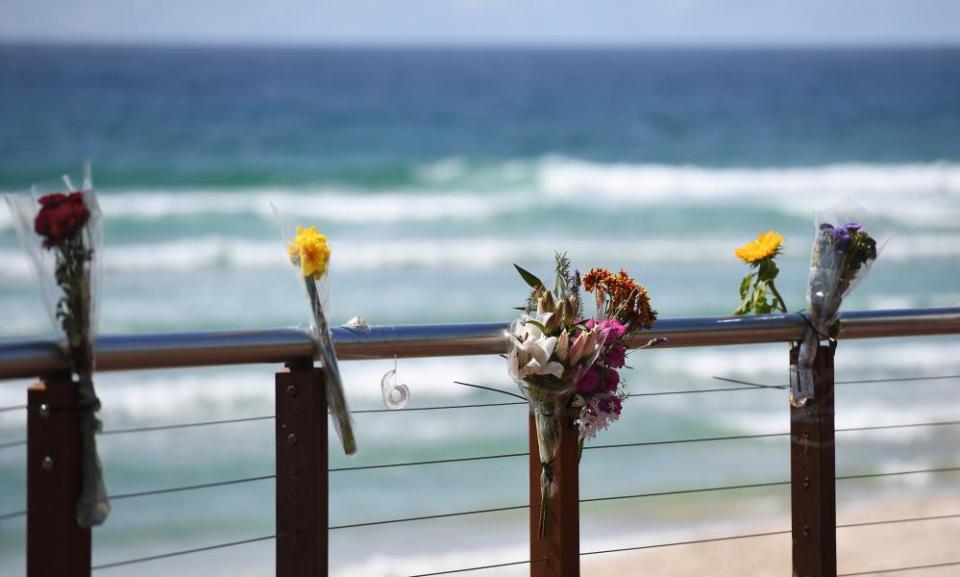Gold Coast surfer killed by shark may have died before being helped to shore, witnesses say

Gold Coast surfer Nick Slater was paddling in barely waist-deep water when he was attacked by a shark and the 46-year-old may have died before he was helped to the shore, witnesses have said.
Tuesday’s incident was the first fatal shark attack at the tourist destination’s beaches since 1958 and it has reignited the debate about the efficacy of nets and drumlines.
Witnesses say the shark came within metres of several other board riders on Tuesday evening at Greenmount Beach, a popular surf break with a shark control net and eight separate drumlines (baited hooks) in place to protect beachgoers.
The attack is the only second death caused by a shark at a netted beach in Queensland since its shark control program was first introduced in 1962, a statistic often held up to laud the success of the state’s lethal protection measures.
Related: Drones and drumlines: can Australian seas ever be safe from shark attacks?
Fellow surfer Jade Parker was getting ready to hit the water when he spotted Slater – a local real estate agent – floating motionless next to his board.
He waded out to help other surfers and lifeguards bring Slater back to the beach. Parker found a four centimetre tooth lodged in Slater’s board which he said was from “an obvious white pointer”.
“It was a good size bite to the board,” he told the Seven Network on Wednesday. “I do not want to get to the gory parts but he was in a bad way. He was not conscious. It looked like he had already pretty much passed away at that point in time.”
Fellow surfer Shane Dowling told Guardian Australia he “certainly” had sharks on his mind when he went for a surf at Greenmount beach about an hour before the attack. He and others saw seagulls diving for baitfish which are known to attract sharks.
“Everyone thinks about sharks if you’re surfing – everyone knows they can come beyond the nets,” Dowling said. “The exact spot where he got attacked is where he was standing the day before. They’ve been packing in a lot of sand and it’s built the beach right out. It was really murky from the sand and really rough in that spot. It was only waist-deep water.”
Dowling said he saw something out beyond the shark nets as he came in from his surf. “I had a good look at it because I thought it might be in the shark net. I could see splashing. It just looked odd. Maybe it was shark feeding on the school behind the net before I came in.”
Witnesses said the shark took a large chunk – about the size of a basketball – from Slater’s surfboard. The wounds on his upper leg were significant.
“It was a pretty severe attack and the ambulance and paramedics were here and did what they could, but it was to no avail,” the Gold Coast’s chief lifeguard, Warren Young, told the ABC.
The Gold Coast’s reputation for relatively safe beaches is a drawcard for tourists.
The incident on Tuesday has prompted new conversations about the effectiveness of nets and drumlines to protect beachgoers and whether they create a false sense of security for swimmers who mistakenly think are a catch-all defence.
The local mayor, Tom Tate, a long-time advocate of shark control programs, on Wednesday flagged he would speak to the state government about additional measures.
“It brings to reality, when we go off the land we go into the water, it is the shark’s domain. The danger’s there,” Tate said.
“Let me speculate that maybe there are sonic solutions that could do better and we should have a look at that ... but one of the options might be to continue with the current solutions.
“Together with the minister, I will be analysing what is the better remedy ... but let’s be guided by the experts. I’m sure we can come up with best solution for our beaches.”
The state premier, Annastacia Palaszczuk, said she believed Queensland’s shark control program had been saving lives for generations.
“If improvements can be made, then of course they should be, but the ultimate goal has to be protecting human life,” she said. The premier praised Parker and the other rescuers who helped Slater as “heroes”.
“The courage to run into the surf moments after a shark attack is beyond admirable,” she told parliament.
Shark experts said no protection measures can make any place safe. “The shark nets aren’t there to stop sharks coming through,” said George Roff, an ecology professor from the University of Queensland.
“They’re 400-600 metres away from the main beach and they don’t [stretch across the length of the beach] to block everything coming in.”
Roff said there was no evidence that nets or drumlines prevent or reduce attacks. He said drones and other detection measures were more effective at mitigating risk. “The idea that you can control sharks, in general, is wrong,” he said.
Two tiger sharks have been caught in a net and on a drumline near Greenmount beach since the fatal attack but it’s not known if they are linked to Slater’s death.
Beaches remain officially closed to swimmers from the New South Wales border to Burleigh Heads.
- with Australian Associated Press

 Yahoo Sport
Yahoo Sport 





































